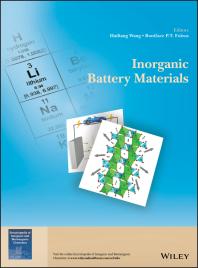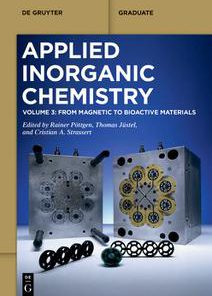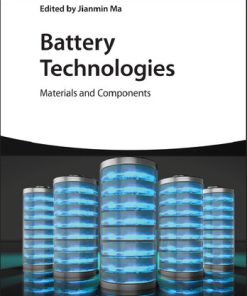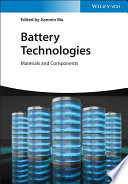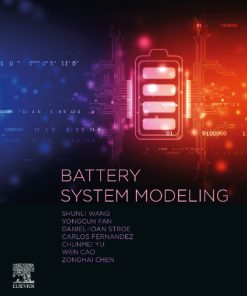Inorganic Battery Materials 1st Edition by Hailiang Wang, Boniface Fokwa ISBN 1119432014 9781119432012
$50.00 Original price was: $50.00.$25.00Current price is: $25.00.
Inorganic Battery Materials 1st Edition by Hailiang Wang, Boniface P. T. Fokwa – Ebook PDF Instant Download/Delivery: 1119432014, 978-1119432012
Full download Inorganic Battery Materials 1st Edition after payment
Product details:
ISBN 10: 1119432014
ISBN 13: 978-1119432012
Author: Hailiang Wang, Boniface P. T. Fokwa
Inorganic Battery Materials 1st Edition:
A guide to the fundamental chemistry and recent advances of battery materials
In one comprehensive volume, Inorganic Battery Materials explores the basic chemistry principles, recent advances, and the challenges and opportunities of the current and emerging technologies of battery materials. With contributions from an international panel of experts, this authoritative resource contains information on the fundamental features of battery materials, discussions on material synthesis, structural characterizations and electrochemical reactions.
The book explores a wide range of topics including the state-of-the-art lithium ion battery chemistry to more energy-aggressive chemistries involving lithium metal. The authors also include a review of sulfur and oxygen, aqueous battery chemistry, redox flow battery chemistry, solid state battery chemistry and environmentally beneficial carbon dioxide battery chemistry. In the context of renewable energy utilization and transportation electrification, battery technologies have been under more extensive and intensive development than ever. This important book:
- Provides an understanding of the chemistry of a battery technology
- Explores battery technology’s potential as well as the obstacles that hamper the potential from being realized
- Highlights new applications and points out the potential growth areas that can serve as inspirations for future research
- Includes an understanding of the chemistry of battery materials and how they store and convert energy
Written for students and academics in the fields of energy materials, electrochemistry, solid state chemistry, inorganic materials chemistry and materials science, Inorganic Battery Materials focuses on the inorganic chemistry of battery materials associated with both current and future battery technologies to provide a unique reference in the field.
About EIBC Books
The Encyclopedia of Inorganic and Bioinorganic Chemistry (EIBC) was created as an online reference in 2012 by merging the Encyclopedia of Inorganic Chemistry and the Handbook of Metalloproteins. The resulting combination proves to be the defining reference work in the field of inorganic and bioinorganic chemistry, and a lot of chemistry libraries around the world have access to the online version. Many readers, however, prefer to have more concise thematic volumes in print, targeted to their specific area of interest. This feedback from EIBC readers has encouraged the Editors to plan a series of EIBC Books [formerly called EIC Books], focusing on topics of current interest.
EIBC Books will appear on a regular basis, will be edited by the EIBC Editors and specialist Guest Editors, and will feature articles from leading scholars in their fields. EIBC Books aim to provide both the starting research student and the confirmed research worker with a critical distillation of the leading concepts in inorganic and bioinorganic chemistry, and provide a structured entry into the fields covered.
Inorganic Battery Materials 1st Edition Table of contents:
Part 1: Chemistry of Li‐Ion Battery Materials
Chapter 1: Silicon‐Based Anodes for Advanced Lithium‐Ion Batteries
1.1 Introduction
1.2 Nanostructure Design
1.3 Binder Effect
1.4 Electrolyte Optimization and Interphase Engineering
1.5 Practical Perspectives of S‐Based Anodes in Full Cells
1.6 Challenges and Outlook
1.7 Abbreviations and Acronyms
1.8 References
Chapter 2: Surface Chemistry of Alkali‐Ion Battery Cathode Materials
2.1 Introduction
2.2 Surface Chemistry of Cathode Materials
2.3 Conclusion
2.4 Acknowledgment
2.5 Related Article
2.6 Abbreviations and Acronyms
2.7 References
Part 2: Lithium Metal Battery Materials
Chapter 3: Li‐CO2 Batteries
3.1 Introduction
3.2 Reaction Mechanism
3.3 Influence Factors of Li–CO2 Batteries
3.4 Cathode Materials
3.5 Conclusion
3.6 Abbreviations and Acronyms
3.7 References
Chapter 4: S Electrode Materials
4.1 Introduction
4.2 Electrochemistry of Lithium–Sulfur Batteries
4.3 Sulfur Cathode Host Materials
4.4 Summary
4.5 Related Articles
4.6 Abbreviations and Acronyms
4.7 References
Chapter 5: Lithium Metal Anode
5.1 Introduction
5.2 Characterization of Lithium Dendrite and Anode Surface Chemistry
5.3 Intrinsic Property of SEI Layer on Lithium Metal Surface
5.4 Modeling of Lithium Dendrite Growth
5.5 Strategies to Protect Metallic Lithium Anode
5.6 Summary and Outlook
5.7 Related Article
5.8 Abbreviations and Acronyms
5.9 References
Chapter 6: Lithium Oxygen Battery
6.1 Introduction
6.2 O2 Redox in Li+‐Containing Aprotic Solutions
6.3 Main Challenges and Research Efforts to Improve Performance in Li–O2 Batteries
6.4 Conclusion and Future Outlook: From O2 to Air—Realizing Li–Air Batteries
6.5 Abbreviations and Acronyms
6.6 References
Chapter 7: Structural Engineering of Cathode Materials for Lithium‐Sulfur Batteries
7.1 Introduction
7.2 Design and Engineering of Sulfur Cathodes
7.3 Summary and Outlook
7.4 Acknowledgments
7.5 Abbreviations and Acronyms
7.6 References
Part 3: Materials and Chemistry of Non-Lithium Batteries
Chapter 8: How to Maximize the Potential of Zn‐Air Battery: Toward Acceptable Rechargeable Technology with or without Electricity
8.1 Introduction
8.2 Zn–Air Battery—Overview
8.3 Perspective View of a Possibility as a Primary and Mechanically Rechargeable Zn–Air Battery
8.4 Perspective View of a Possibility as an Electrically Rechargeable Zn–Air Battery
8.5 Conclusion
8.6 Acknowledgment
8.7 Related Article
8.8 Abbreviations and Acronyms
8.9 References
Chapter 9: Solid State and Materials Chemistry for Sodium‐Ion Batteries
9.1 Introduction
9.2 Electrodes and Their Mechanisms
9.3 Electrolytes
9.4 Mechanism—Surface Chemistry During Electrochemical Cycling
9.5 State‐of‐the‐Art Characterization Tools
9.6 Conclusions
9.7 Acknowledgments
9.8 Abbreviations and Acronyms
9.9 References
Chapter 10: Multivalent Metallic Anodes for Rechargeable Batteries
10.1 Introduction
10.2 Zinc Anodes
10.3 Iron Anodes
10.4 Magnesium Anodes
10.5 Aluminum Anodes
10.6 Calcium Anodes
10.7 Conclusions
10.8 Related Article
10.9 Abbreviations and Acronyms
10.10 References
Chapter 11: Redox-Active Inorganic Materials for Redox Flow Batteries
11.1 Introduction
11.2 Iron–Chromium Redox Flow Battery
11.3 Vanadium Redox Flow Battery
11.4 Zinc‐based Inorganic Redox Flow Batteries
11.5 All-Iron Redox Flow Battery
11.6 Polyoxometalate and Heteropolyacid Redox Flow Battery
11.7 Polysulfide–Polyhalide Redox Batteries
11.8 Other Nonaqueous Inorganic Redox Flow Batteries
11.9 Perspective
11.10 Conclusion
11.11 Acknowledgments
11.12 Abbreviations and Acronyms
11.13 References
Chapter 12: Electrode and Electrolyte Interaction in Aqueous Electrochemical Energy Storage
12.1 Introduction
12.2 Electrode and Electrolyte Interaction in Extending the Potential Window of Aqueous Energy Storage
12.3 Electrode and Water Interaction in Improving the Kinetics of Aqueous Energy Storage
12.4 Future Research Directions
12.5 Acknowledgments
12.6 Abbreviations and Acronyms
12.7 References
Chapter 13: Na-Ion Batteries: Positive Electrode Materials
13.1 Introduction
13.2 Layered Transition Metal Oxides (N MO2; M = Transition Metal)
13.3 Fluoride Systems (NMF3)
13.4 Polyanion Systems
13.5 Prussian Blue/White Materials
13.6 Conclusions
13.7 Related Article
13.8 Abbreviations and Acronyms
13.9 References
Part 4: Electrolyte Chemistry for Rechargeable Batteries
Chapter 14: Solid-State Electrolyte
14.1 Introduction
14.2 Lithium Oxide Systems
14.3 Lithium Sulfide Systems
14.4 Thin‐Film SSE
14.5 Hydrides and Other SSE
14.6 Summary/Conclusion
14.7 Abbreviations and Acronyms
14.8 References
Chapter 15: Chemistry of Soft Matter Battery Electrolytes
15.1 Introduction
15.2 Ionic Conductivities and Lithium (Sodium) Transference Numbers
15.3 Soft Matter Lithium and Sodium Electrolytes
15.4 Stability of the Electrolyte/Electrode Interfaces
15.5 Specific Electrolyte Issues in Li–S and Li–O2 Batteries
15.6 Electrolytes for Multivalent Batteries
15.7 Conclusions and Outlook
15.8 Abbreviations and Acronyms
15.9 References
Chapter 16: Modeling Solid State Batteries
16.1 Introduction
16.2 Atomistic Modeling for Solid‐State Batteries
16.3 Continuum Modeling for Solid State Battery
16.4 Abbreviations and Acronyms
16.5 References
Part 5: Advanced Characterizations of Inorganic Battery Materials
Chapter 17: TEM Studies on Electrode Materials for Secondary Ion Batteries
17.1 Introduction
17.2 Cathode Materials
17.3 Anode Materials
17.4 In Situ TEM
17.5 Outlook
17.6 Related Article
17.7 Abbreviations and Acronyms
17.8 References
Chapter 18: Synchrotron-Based Soft X-Ray Spectroscopy for Battery Material Studies
18.1 Introduction
18.2 Synchrotron-Based SXS Techniques
18.3 General SXS Demonstrations of Batteries
18.4 K‐Edge sXAS of Low‐Z Elements in Batteries
18.5 sXAS for Quantifying TM Cationic Redox Reactions
18.6 RIXS for Detecting the Subtle Chemical Contrast
18.7 mRIXS for Detecting Novel Mn Redox States
18.8 mRIXS Fingerprints Oxygen Redox States
18.9 Perspectives on in Situ SXS of Batteries
18.10 Summary and Conclusions
18.11 Acknowledgment
18.12 Related Articles
18.13 Abbreviations and Acronyms
18.14 References
Chapter 19: Solid Electrolyte Interphase in Lithium-Based Batteries
19.1 Introduction
19.2 The Passive Layer on Lithium
19.3 Catalysis Effect
19.4 Mechanical Effect
19.5 Properties of SEI
19.6 Potential Causes of Controversy during Surface Characterization
19.7 Future Prospects
19.8 Acknowledgments
19.9 Related Article
19.10 Abbreviations and Acronyms
19.11 References
Chapter 20: Application of In Situ Electrochemical-Cell Transmission Electron Microscopy for the Study of Rechargeable Batteries
20.1 Introduction
20.2 Application in Lithium‐Ion Batteries
20.3 Application in Metal–Air Batteries
20.4 Conclusions and Outlook
20.5 Acknowledgments
20.6 Related Article
20.7 Abbreviations and Acronyms
20.8 References
People also search for Inorganic Battery Materials 1st Edition:
what are some inorganic materials
types of battery materials
inorganic battery
inorganic lithium battery
an organic material
Tags:
Hailiang Wang,Boniface Fokwa,Inorganic,Battery,Materials
You may also like…
Uncategorized
Chemistry - Inorganic Chemistry
Engineering - Civil & Structural Engineering
Computers - Artificial Intelligence (AI)
Chemistry - Inorganic Chemistry
Applied Inorganic Chemistry Volume 3 From Magnetic to Bioactive Materials 1st Edition Rainer Pöttgen
Engineering - Energy & Power Resources
Battery Technologies Materials and Components 1st Edition Jianmin Ma
Chemistry - Technical & Industrial Chemistry
Chemistry - Inorganic Chemistry
Engineering

